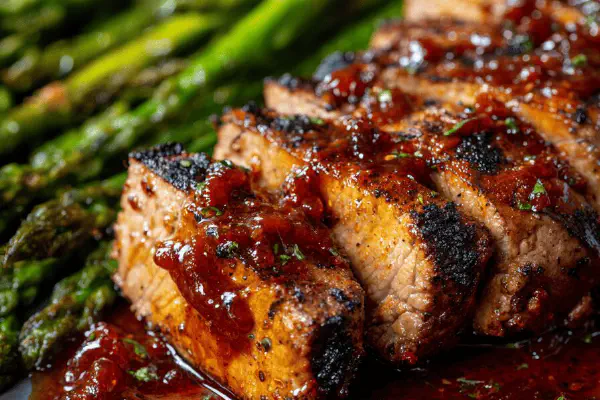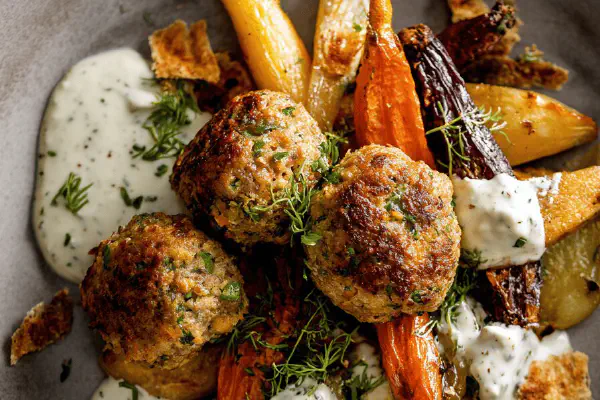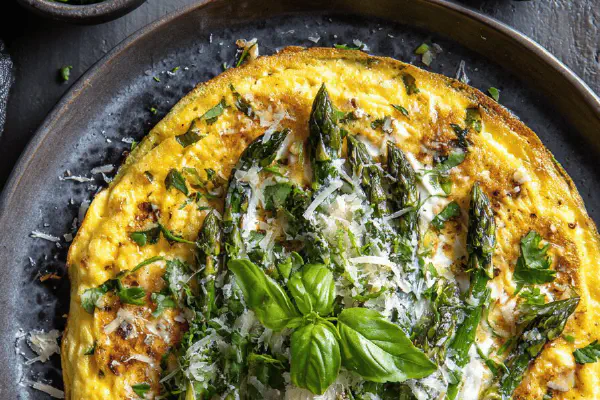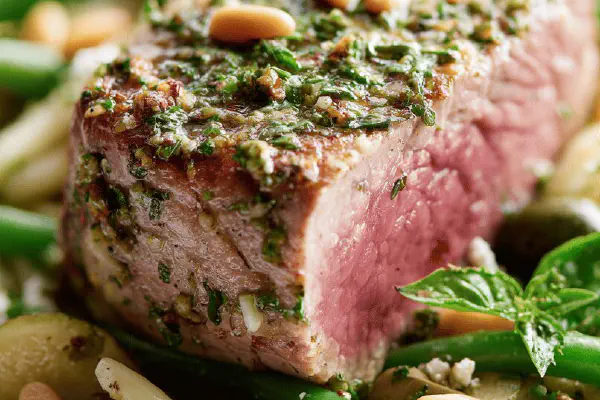Glazed Pork Filets Fig Herbs

By Emma
Certified Culinary Professional
Ingredients
- 2 pork filets about 240 g each
- 25 ml olive oil (about 1.5 tablespoons)
- 4 ml salt (slightly less than 1 teaspoon)
- 2 sprigs oregano
- 2 sprigs basil
- 2 garlic cloves, halved
- 25 ml apricot jam (about 1.5 tablespoons)
- 5 ml balsamic vinegar (about 1 teaspoon)
About the ingredients
Method
- Herbs and garlic tossed with olive oil and salt. Pork rubdown. Rest 10-15 minutes ambient.
- Heat oven 200 °C (390 °F). Place rack mid-level.
- Pan sear filets over high heat with herbs and garlic. Get caramelization all over. 4-5 minutes total.
- Into oven, roast 17-18 minutes. Flip halfway. Cook to 62 °C (143 °F) internal temp. Pink, juicy inside.
- Mix apricot jam with balsamic vinegar.
- Remove from oven, brush tops with glaze. Let rest 7 minutes uncovered.
- Carve thin slices. Serve alongside asparagus dressed in spicy romesco sauce.
Cooking tips
Chef's notes
- 💡 Rub pork filets gently but thoroughly with olive oil, salt, oregano, basil and halved garlic. Let sit at room temp for 10-15 mins before cooking. This helps flavor seep and meat warm evenly. Avoid overcrowding pan to get even caramelization on all sides during sear.
- 💡 Use fresh herbs when possible; oregano and basil bring earthier, Mediterranean base compared to rosemary and thyme. Toss herbs and garlic with oil before rubbing onto pork. Garlic halves create pockets of flavor during sear but remove any burnt bits to prevent bitterness.
- 💡 High heat sear crucial for crust; 4-5 minutes total, turning often. Sear evenly all sides. Follow immediately with roasting at 200 °C (390 °F) for 17-18 mins, flipping once to get uniform cook. Target internal temp 62 °C (143 °F) for pink with texture dense but tender.
- 💡 Mix apricot jam with balsamic vinegar just before glazing. Thick jam works best so glaze clings well. Apply glaze while pork is hot straight from oven for tacky finish. Rest uncovered 7 minutes to let juices redistribute and glaze set without steaming.
- 💡 Serve sliced thin, not thick chunks. Thin slices show pink interior, tender texture. Balance richness with spicy smoky romesco tossed asparagus; crunch contrasts softness. Timing and seasoning keep texture dense but juicy. Don’t skip resting to lock in juices and let glaze meld.
Common questions
Why use apricot jam instead of fig jam?
Apricot jam gives lighter fruit punch, less dense sweetness. Fig jam richer, deeper flavor. Apricot blends well with balsamic vinegar’s acidity. Different balance but both sticky enough to glaze. Depends how sharp or sweet you want.
Can I substitute herbs?
Sure, oregano and basil chosen for earthiness. Rosemary or thyme will change flavor profile, more piney or floral. Fresh preferred over dried. If no fresh, use half quantity dried to avoid overpowering. Blending herbs affects final aroma and meat taste.
How to know pork is done without thermometer?
Touch test less reliable here due to pink center goal. The 17-18 mins roasting time after sear approximates 62 °C internal temp. Flip halfway for even cooking. Meat should feel firm but slightly springy. Err on side less cook to keep juiciness.
Can leftovers be stored and reheated?
Yes refrigerated within 2 hours, keep sliced or whole wrapped tight. Reheat gently to avoid drying; use oven at low temp or warm pan quickly. Glaze might get sticky or dry off; add small splash water or fresh glaze if needed. Consume within 2-3 days.



